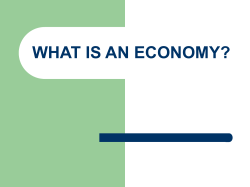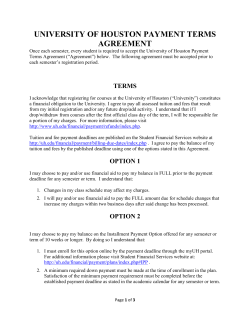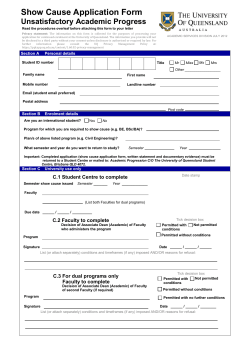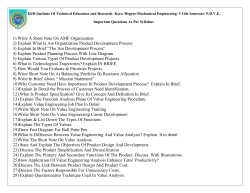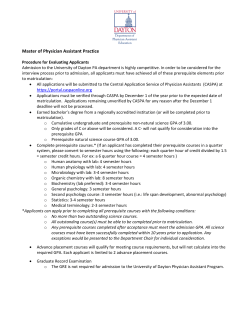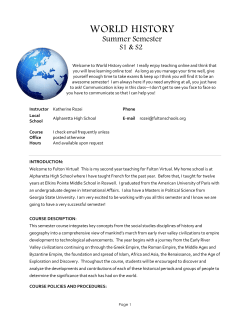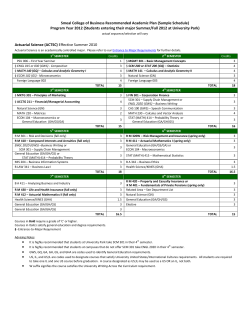
Document 241652
Water Resources Management Spring Semester 2014 WATER RESOURCES MANAGEMENT Spring semester 2014 course introduc,on Water resources planning and management: what is it about? [Integrated] Water Resources Management (IWRM) is the coordinated development and management of water, land and related resources in order to maximise economic and social welfare without compromising the sustainability of ecosystems and the environment. [Global Water Partnership, h1p://www.gwp.org/The-‐Challenge/What-‐is-‐IWRM/] IWRM is a complex task, which, in a modern perspec9ve, clusters competences from different disciplines: • engineering, economy, ecology, sociology, law, and poli,cs in order to secure • water use efficiency • ecological integrity and/or restora,on of aqua,c ecosystems • clean water bodies • equity and par,cipa,on in decision making • respect of ins,tu,onal and legal frameworks Course introduc9on 1 Water Resources Management Spring Semester 2014 WRM problems • planning, design and operaBon of water infrastructures (reservoirs, pipelines, channels, …) • uneven distribuBon of resources in space and Bme (due to streamflow regime variability) • water scarcity (due to inherently scarse resource or to imbalance between demand and available resource) • compeBBve use (upstream – downstream, among sectors and among countries) • water conservaBon (sustainable alloca9on) • aquaBc ecosystems preservaBon • polluBon prevenBon • access to water WR manager competences • core competences in water engineering planning design opera9on • side competences in ecology of aqua9c ecosystems decision making financial management • communicaBon and negoBaBon skills team work interac9on with authori9es, poli9cians and stakeholders media9on skills Course introduc9on 2 Water Resources Management Spring Semester 2014 Water uses • IrrigaBon: dominant consumpBve use • Imbalance among sector and across world regions irriga9on vs domes9c and industrial • conservaBon of resources • preservaBon of aquaBc ecosystem • maximizaBon of (conflicBng) benefits • legal framework Water uses Need for be<er water resources management NB IrrigaBon per capita remained almost constant Course introduc9on 3 Water Resources Management Spring Semester 2014 Example of WRM problem: planning water infrastructures RESERVOIR SYSTEM PURPOSE • designed to solve uneven water distribuBon • operated to saBsfy mulBple uses irriga9on water supply hydropower genera9on CONSTRAINTS • conservaBon of resources • preservaBon of aquaBc ecosystem • maximizaBon of (conflicBng) benefits • legal framework [WBCSD, Facts and trends: water, 2005] Example of WRM problem: water scarcity (1) Renewable water [m3/anno /capita] carenza: >1000÷2000 m3/a/pers. 4000÷10000 insufficienza: <1000 m3/a/pers. 1000÷1700 <500 missing 500÷1000 1700÷4000 data >10000 Course introduc9on 4 Water Resources Management Spring Semester 2014 Example of WRM problem: water scarcity (2) Freshwater stress: withdrawal/annual availability >40% 40÷20% 20÷10% <10% [WBCSD, Facts and trends: water, 2005] Example of WRM problem: water scarcity (3) DIA = Domes9c, Industrial and Agricultural uses Q = River streamflow for a given basin year 1985 [Vörösmarty et al., Science, 2000] Course introduc9on 5 Water Resources Management Spring Semester 2014 Example of WRM problem: water scarcity (4) ΣDIA / Q = accumulated rela9ve water demand from all water sectors along main-‐ stem rivers à aggregated imprint Rela9ve change in demand per discharge under climate and popula,on change forcings Water reuse index: ΣDIA/Q Significant impact on transboundary rivers [Vörösmarty et al., Science, 2000] Water scarcity – anthropogenic causes [from Dinar et al. 2007] Enhancing water scarcity • DepleBon of water quality (pollu9on increase) • Increase of living standards (domes9c appliances) MiIgaIng water scarcity • Country technological level (recycling, efficient irriga9on and water supply) Course introduc9on 6 Water Resources Management Spring Semester 2014 InternaIonal dimension of WRM • InternaBonal Water Bodies (IWBs) are those shared by two or more independent states • Increase of IWBs because of newly created states • Source of conflicts because of upstream-‐downstream conflicts among riparian states equitable alloca9on pollu9on flood and drought controls Transboundary WR problems – Europe Danube • Crimean War and General Treaty of Peace (1856): rules of naviga9on on Danube river Congress of Vienna (1815): treaty to establish rules of naviga9on on river Rhine • Danube Commission’s goals: sustainable and equitable water management conservaBon, improvement and the raBonal use of surface waters and ground water appropriate legal, administraBve and technical measures # of Countries Shared basin 17 Int. Comm. Protec. Rhine against Pollu9on (ICPR1950) Danube 9 Rhine 5 Vistula • Example of dispute: Hungary vs Slovakia (Gabcikovo-‐ Nagymaros Project – hydropower, flood control, channeling) [Wolf et al., 1999] Course introduc9on 7 Water Resources Management Spring Semester 2014 Transboundary WR problems – Africa Nile • Historic vs sovereign water rights • Trea9es in 1929 and 1959 between Egypt and Sudan # of Countries Shared basin 11 Congo, Niger 10 Nile 9 Zambesi 8 Lake Chad 6 Volta 3 Orange • 1999 Nile Basin Ini9a9ve with the goal of equitable alloca9on of flow and development of an integrated watershed plan aiming at efficient water management and op9mal use. • New conflict and co-‐ opera9on problem between Egypt and Ethiopia that claims right to use the Blue Nile waters [Wolf et al., 1999] Transboundary WR problems – Asia # of Countries Shared basin 6 Ganges-‐ Brahmaputra-‐ Meghna 6 Aral Sea 6 Tigris and Euphrates 6 Tarim 6 Mekong Euphrates • earliest water treaty of any kind between Mesopotamian ci9es of Umma and Lagash (3100 B.C.) • Dispute among Turkey (upper riparian), Syria and Iraq (lower riparians) about equitable flow alloca9on • Dam construc9on upstream causing water shortage downstream [Wolf et al., 1999] Course introduc9on 8 Water Resources Management Spring Semester 2014 Transboundary WR problems – North America Rio Grande • Dispute between USA and Mexico (since end 1800) • “Harmon doctrine” (1895): USA enjoy the absolute sovereignty and are free to use all Rio Grande water regardless of consequences for Mexico [Wolf et al., 1999] Transboundary WR problems – South America # of Countries Shared basin 8 Amazon 5 La Plata La Plata basin • 1969: coopera9ve management body • “Hidrovia”: largest project for naviga9onal river development large impact expected on economies and environments world’s largest wetland at risk, also protecBng downstream areas from floods and droughts [Wolf et al., 1999] Course introduc9on 9 Water Resources Management Spring Semester 2014 Ex. of WRM problem: development of legal constraints In the last decade administra9ve and legal constraints increased the pressure on environmental aspects (e.g. EU Water Framework DirecBve) hup://ec.europa.eu/environment/water/water-‐framework/index_en.html “Anyone who solves the problem of water deserves not one Nobel Prize but two – one for science and the other for peace” John Fitzgerald Kennedy Course introduc9on 10 Water Resources Management Spring Semester 2014 Relevant literature Biswas, A.K., (2004) Integrated Water Resources Management: A Reassessment, Water InternaBonal, 29(2), 248-‐256. Dinar, A., S. Dinar, S. McCaffrey, and D. McKinney, (2007) Bridges over Water, World Scien9fic, Singapore, 458 pp. Vorosmarty, C.J., P. Green, J. Salisbury, and R.B. Lammers, (2000) Global Water Resources: Vulnerability from Climate Change and Popula9on Growth, Science, 289, 284-‐288. Wolf, A.T. , J.A. Natharius, J.J. Danielson, B.S. Ward, and J.K. Pender, (1999) Interna9onal River Basins of the World, InternaBonal Journal of Water Resources Development, 15(4), 387 — 427. Course introduc9on 11
© Copyright 2025
